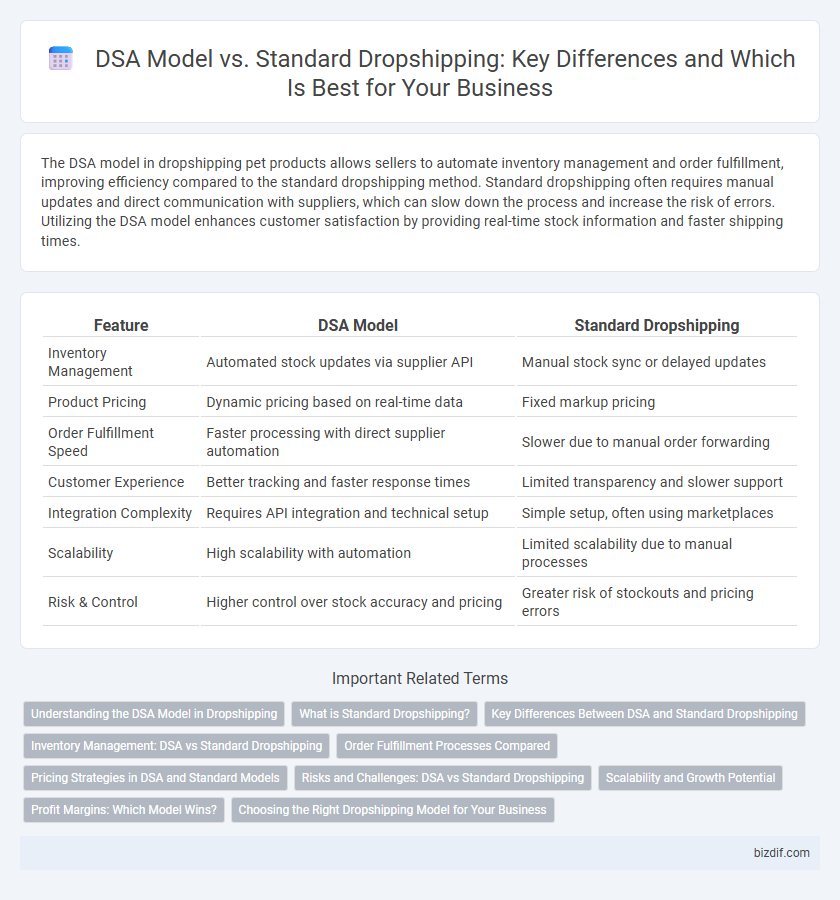The DSA model in dropshipping pet products allows sellers to automate inventory management and order fulfillment, improving efficiency compared to the standard dropshipping method. Standard dropshipping often requires manual updates and direct communication with suppliers, which can slow down the process and increase the risk of errors. Utilizing the DSA model enhances customer satisfaction by providing real-time stock information and faster shipping times.
Table of Comparison
| Feature | DSA Model | Standard Dropshipping |
|---|---|---|
| Inventory Management | Automated stock updates via supplier API | Manual stock sync or delayed updates |
| Product Pricing | Dynamic pricing based on real-time data | Fixed markup pricing |
| Order Fulfillment Speed | Faster processing with direct supplier automation | Slower due to manual order forwarding |
| Customer Experience | Better tracking and faster response times | Limited transparency and slower support |
| Integration Complexity | Requires API integration and technical setup | Simple setup, often using marketplaces |
| Scalability | High scalability with automation | Limited scalability due to manual processes |
| Risk & Control | Higher control over stock accuracy and pricing | Greater risk of stockouts and pricing errors |
Understanding the DSA Model in Dropshipping
The DSA model in dropshipping streamlines inventory management by integrating directly with suppliers, enabling real-time stock updates and faster order fulfillment compared to standard dropshipping. By automating product listing synchronization and pricing adjustments, DSA reduces manual errors and enhances scalability for online stores. This approach improves customer satisfaction through more reliable shipping times and accurate product availability information.
What is Standard Dropshipping?
Standard dropshipping is a retail fulfillment method where the seller does not keep inventory but forwards customer orders directly to a third-party supplier who ships products on behalf of the retailer. This model minimizes upfront investment and inventory management, allowing sellers to focus on marketing and customer service. Key challenges include reliance on suppliers for product quality and shipping times, which can impact customer satisfaction and brand reputation.
Key Differences Between DSA and Standard Dropshipping
The DSA (Direct Supplier Access) model streamlines order fulfillment by allowing sellers to connect directly with manufacturers, reducing intermediaries and often leading to faster shipping times. Standard dropshipping typically involves a third-party supplier or wholesaler, which can result in less control over inventory and longer delivery periods. DSA offers enhanced inventory transparency and pricing control, while standard dropshipping may rely on broader product selections with varying supplier reliability.
Inventory Management: DSA vs Standard Dropshipping
In DSA (Direct Supplier Agreement) models, inventory management is streamlined by maintaining direct synchronization with the supplier's stock levels, reducing the risk of overselling and stockouts. Standard dropshipping relies on manually updating inventory data or third-party integrations, which can lead to delays and inaccuracies. Efficient real-time inventory tracking in DSA models enhances order fulfillment speed and customer satisfaction compared to traditional dropshipping methods.
Order Fulfillment Processes Compared
The DSA model streamlines order fulfillment by automating supplier inventory updates and directly shipping products to customers, significantly reducing manual intervention. Standard dropshipping relies heavily on manual order processing and communication between retailer and supplier, which can increase fulfillment times and error rates. Enhanced automation in the DSA model leads to faster order processing, improved accuracy, and better scalability compared to traditional dropshipping methods.
Pricing Strategies in DSA and Standard Models
Dynamic Search Ads (DSA) in dropshipping employ real-time automated pricing adjustments based on market demand, competitor analysis, and customer behavior, enabling more precise margin optimization. In contrast, standard dropshipping relies on fixed or manually updated pricing strategies, often resulting in slower response to market fluctuations and less competitive pricing. Effective pricing in DSA leverages AI-driven insights to maximize profit, while standard models depend heavily on seller intuition and periodic market reviews.
Risks and Challenges: DSA vs Standard Dropshipping
The DSA model involves direct shipment from suppliers with less control over inventory quality and shipping times, increasing risks of delayed deliveries and customer dissatisfaction compared to standard dropshipping, which typically offers more supplier vetting and managed logistics. Standard dropshipping faces challenges such as inventory synchronization and higher dependency on third-party platforms, but it provides more stable supplier relationships reducing order fulfillment errors. Both models encounter risks of supplier reliability, but DSA's less structured approach amplifies the chances of product inconsistencies and limited tracking visibility.
Scalability and Growth Potential
The DSA model offers enhanced scalability by allowing sellers to diversify product sourcing across multiple suppliers, reducing dependency risks compared to standard dropshipping, which typically relies on a single supplier. This multi-supplier approach in DSA enables faster inventory expansion and improved order fulfillment capacity, driving higher growth potential. Standard dropshipping's limited supplier network often restricts scalability, making it more challenging to manage large order volumes and expand product lines effectively.
Profit Margins: Which Model Wins?
The DSA (Direct Shipping Arbitrage) model often achieves higher profit margins than standard dropshipping due to its focus on sourcing products at lower costs from overseas suppliers and targeting premium markets. Standard dropshipping relies on predefined supplier markups and slower shipping times, which can erode profitability through customer refunds and higher operational costs. By leveraging dynamic pricing and optimized supplier networks, the DSA model maximizes revenue while minimizing overhead, making it the more profitable choice in competitive e-commerce landscapes.
Choosing the Right Dropshipping Model for Your Business
The DSA (Direct Supplier Access) model enhances inventory control and shipping speed by connecting merchants directly with suppliers, reducing reliance on third-party warehouses common in standard dropshipping. Standard dropshipping offers lower upfront costs and simpler setup, making it ideal for beginners or businesses with limited capital. Selecting the right dropshipping model depends on your business goals, target market expectations, and operational capacity to manage supplier relationships or inventory logistics effectively.
DSA Model vs Standard Dropshipping Infographic

 bizdif.com
bizdif.com